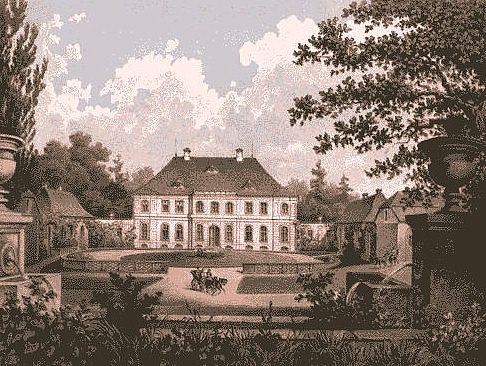| |

Carl Adolph Gottlob von Schachmann (owner), Schloß Königshain (Niesky: Germany: 1760-1766).
But, although the question of army service and honorable wounds is still debatable, fortunately we do know a little about his Niesky period and something of his actual travels in these youthful years. It is clear, for example, that at Niesky he had a friend who watched over him and served, in a sense, in loco parentis--Baron Karl von Schachmann, an eminent Moravian who lived near by in his castle, Konigshain. The baron was deeply religious, most understanding and kind, and a great scholar; he knew England well, was one of Zinzendorf 's secretaries, and had been instrumental in the passage of the Act of 1749 by which Parliament accepted the Moravians as part of the English church. Latrobe notes that the baron's castle was his own "second home" and the place where he passed his happiest German hours.
And the baron was a classical expert, a collector, a connoisseur, and something of an artist as well. His collection of ancient coins and medals was famous, and in 1774 he had published a valuable catalogue of them; later they went to the ducal medal cabinet at Gotha. How Latrobe must have delighted in this collection; what a background in ancient history, what a training in sensitive taste it gave him as he pored over it! Baron von Schachmann was noted, too, for his talent in the painting of landscapes and of architecture. Here then, in Königshain, the growing youth found himself in affectionate association with an older man who could share his own enthusiasms, admire and criticize his precocious drawings, and perhaps even point the way to a different future from the Moravian ministry for which he seems to have been educated. The facts are uncertain, but the probability of the baron's influence in that direction is great. A nephew of Latrobe's, setting down his reminiscences of his father, Christian, states that the architect made the final decision about his profession "about 1783." Both Christian and Benjamin Henry were still in Germany then, and, if by that time the younger brother had acknowledged his hope of becoming an architect, surely the influence of the elderly baron an enthusiast for architecture and presumably his most beloved German friend--can be inferred.
--Talbot Hamlin, Benjamin Henry Latrobe (New York: Oxford University Press, 1955), p. 15.
| |
|